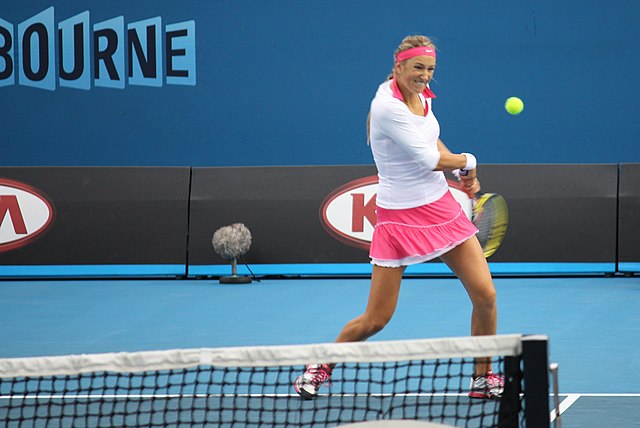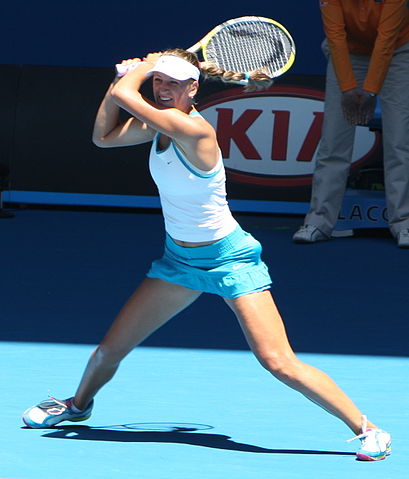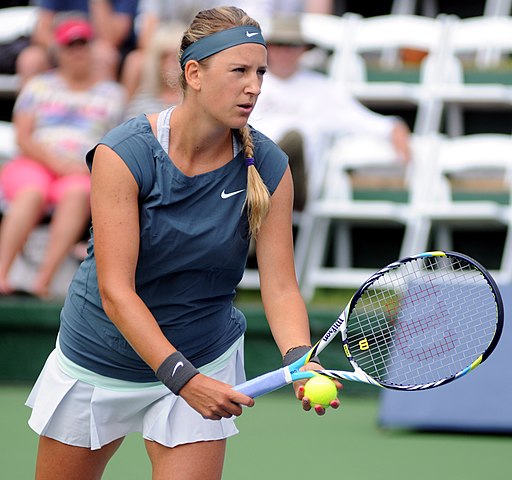
Credit: n.hewson
In 2022, I’m counting down the 128 best players of the last century. With luck, we’ll get to #1 in December. Enjoy!
* * *
Victoria Azarenka [BLR]Born: 31 July 1989
Career: 2006-present
Plays: Right-handed (two-handed backhand)
Peak rank: 1 (2012)
Peak Elo rating: 2,326 (1st place, 2013)
Major singles titles: 2
Total singles titles: 21
* * *
The first time I saw Victoria Azarenka play was by accident. I had Arthur Ashe Stadium tickets for the 2007 US Open men’s quarter-finals, and without much happening on the outer courts, I settled in for the mixed doubles championship match. Leander Paes, at least, was sure to give me my money’s worth.
He did, but the star of the afternoon was an 18-year-old Belarussian in her second grand slam final. Vika partnered her countryman, the doubles specialist Max Mirnyi, and she seemed committed to proving the old saw that in mixed doubles, women make all the difference. She hit the hardest of the foursome, and in case anyone didn’t notice, every shot was punctuated with the two-part grunt that all tennis fans would soon know well.
Azarenka and Mirnyi beat Paes and Meghann Shaughnessy for the title, 6-4, 7-6. The Belarussians had also reached the final in Australia, and Vika would appear in another two major doubles finals the following year. She reunited with Mirnyi for the mixed event at the 2012 London Olympics, where the slam-winning pair earned a gold medal.*
* BBC headline: “Andy Murray & Laura Robson take silver in Olympics final”
The hard-hitting teen wasn’t destined for a career as a doubles specialist, of course. Her achievements alongside Mirnyi would soon be relegated to a footnote, something for television commentators to mention when she made a rare foray beyond the service line.
In 2005, Vika won two of the four junior slams as a singles player. By the 2007 US Open, her ranking was on the brink of the top 40, with a tour-level final in Estoril already to her credit. A few weeks later in Luxembourg, she recorded her first top-ten win, backing it up in October with an upset of the number four player in the world, Maria Sharapova. Facing three set points against Masha in the Moscow second round, she kicked off a run of ten straight points and fought out a 16-point tiebreak.
Azarenka appeared to be on the brink of great things. She would, in fact, steadily improve. Compared to the sudden breakthroughs that had defined women’s tennis for decades, though, the Belarussian’s ascent moved slowly.
Vika’s path, both in reaching the top and in finding her place as a less-dominant veteran, has always been complicated.
* * *
Azarenka’s reign as an elite player can be dated, roughly, to March of 2011.
She first broke into the top ten almost two years earlier, on the strength of a 2009 Miami title when she beat an injured Serena Williams. But in a crowded field, she struggled to establish herself as more than a fringe member of the top tier. In seven hard-court tournaments after Wimbledon that year, she won only nine matches.

Credit: Brett Marlow
In 2011, by contrast, Miami was a springboard, not an aberration. Vika defeated second-seed Kim Clijsters, third-seed Vera Zvonareva, and Sharapova back-to-back–all in straight sets, no less–to win the title for the second time. She followed it up with a champion’s trophy in Marbella. To this day, it is her only tournament victory on a clay court.
While she didn’t win another title until Luxembourg in October, Azarenka’s failure to do so said more about the depth of the tour than any inconsistency on her part. She lost to Petra Kvitová in the Madrid final and the Wimbledon semis. Li Na beat her in the French Open quarters, en route to the title. At both Toronto and the US Open, Azarenka lost to Serena, giving the American champion a hard fight in the Flushing third round.
Williams was the 28th seed in New York, a hilariously bad draw for the up-and-coming star. It was of a piece with her season to that point. Pete Bodo wrote in August of that year, “Very few women in tennis history have played as well as Azarenka through three majors and come away without even a final berth for it.” She had yet to reach number three in the rankings, but Bodo was ready to appoint her as a close second on the “Best Active Player Not to Have Won a Major” list, behind only Caroline Wozniacki.
At the season-ending WTA Championships, Vika again came up short. She beat Li, Zvonareva, and Sam Stosur, then fell in three sets to Kvitová in the final. Her serve–the one part of her game that has never been particularly imposing–proved to be her downfall. She was unusually conservative with her first offerings, landing more than three in four. The Czech ate them up and won nearly half of those points. In a close match, a single weakness was enough to make the difference.
Still, Azarenka finished third on the year-end ranking list. The final step to superstardom was in sight.
* * *
The Vika who returned for the 2012 campaign was the one who a later headline writer would call “The Most Intense Tennis Player on Earth.” She was finally able to channel all of that intensity toward victory.
The rest of the tour could only watch in awe, perhaps hoping they’d land in the other half of the draw next time. Azarenka began the season with 26 straight wins, grabbing titles at Sydney, Doha, and Indian Wells–and in between, at the Australian Open. The (second) best active player without a major now had one.
In Melbourne, she needed an extended warmup before overwhelming eighth-seed Agnieszka Radwańska. She lost seven straight points and a tiebreak, then came back to win the next two sets, 6-0, 6-2. She allowed Sharapova only three measly games in an overpowering final.
The scariest part was, she seemed to improve every week. In Sydney and Melbourne, Radwańska was able to take a set. Azarenka beat her in straights in Doha the following month, and then at Indian Wells, Vika clobbered her, 6-0, 6-2. She no longer needed the wake-up call of a lost opening frame. In the Indian Wells final, Azarenka confirmed her victory over Sharapova, winning another easy straight-setter.
In 79 matches that season, Vika won 15 bagel sets and another 24 by the score of 6-1. A few years later, Tom Perrotta described the attitude that allowed her to destroy first-class opponents:
She fights for points when ahead, when behind, when there’s little chance of winning them. In the first round [at the 2016 Australian Open], she beat Alison Van Uytvanck 6-0, 6-0. At one point in the first set, Azarenka had a comfortable lead when Van Uytvanck served at 40-0, one point from winning what would likely be a meaningless game. Azarenka scrapped and won the next three points, and eventually the game.
That fall, she reeled off 13 consecutive wins–including titles Beijing and Linz and another day at the beach against Sharapova–without losing a single set. No one even got to 5-all against her. In a match with a young Simona Halep during that span, she won a breathtaking 70% of the total points played.
The Australian Open victory was enough to propel Vika into the number one position on the WTA computer. Except for four weeks that summer, she held on to the top spot for a full year. In the half-century since the tour began maintaining rankings, only eleven other women have been number one for more than her total of 51 weeks.
* * *
As you might have noticed, I skipped over a big chunk of Azarenka’s 2012 season. She reached the final in Madrid… and lost to Serena Williams. She made it to the semi-finals at Wimbledon… and lost to Serena. In the final four at the Olympics, she lost to Serena. (Here, at least, there was a consolation prize: She won the bronze medal the next day by defeating Maria Kirilenko.) She beat Sharapova to reach her first US Open final… where she lost to Serena.
Vika dropped just ten matches that year. Five of them came against Williams. At the end of the season, their career head-to-head stood 11-1 in Serena’s favor. The single Azarenka victory came from their meeting at Miami in 2009, when the veteran was hampered by a leg injury.
In 2017, Serena’s then-coach Patrick Mouratoglou told the New York Times:
I always thought that if Serena hadn’t blocked her path, she would have lots of Grand Slam titles. Serena really hurt her, because Azarenka was very, very, very close to acquiring so much confidence that she would have been unstoppable.
The 2012 US Open final explains why Patrick said “very” three times. Williams was even more imperious than usual in New York. When she met Vika in the final, she had just beaten Sara Errani, 6-1, 6-2, winning more than 90% of points behind her first serve. She hadn’t dropped a set in six rounds.
Serena opened the final in the same form, winning the first set, 6-2. But Azarenka brought the set streak to an end, making quick work of the second by the same score. Vika was one of the few players who could absorb the American’s hardest shots, shrug off the unreturnable serves, and find enough opportunities to make Williams look vulnerable.
Azarenka and Williams before the 2009 Miami final
At 3-all in the third set, Serena offered up a sloppy service game. Azarenka broke at love and held for 5-3. But that was as far as the challenger could go. Williams held for 5-4, and she immediately put pressure back on the Azarenka serve. Vika’s normally sturdy backhand started spitting errors. She had two chances to force a tiebreak, but the backhand had lost its punch, and Serena secured the victory, 7-5.
Not every Vika-Serena match was so dramatic. The US Open final was only the second time Azarenka had even forced a third set. But the Belarussian could handle Serena’s pace and intensity. While the head-to-head record didn’t show it, she was as close to dethroning the queen as anyone else on the circuit. According to the WTA ranking formula, she had already done so.
* * *
2013 started almost as well as the year before. Vika defended her Australian Open title with a final-round victory over Li Na. In Doha the following month, she came out on the winning side of a mammoth battle against Serena, beating her long-time tormentor, 7-6, 2-6, 6-3.
While the result hinted at the onset of a new era, it was instead a high point for the Belarussian. Williams’s run in Doha gave her the points to nudge Vika out of the number one ranking position, despite the outcome of the final. At Indian Wells a few weeks later, Azarenka reached the quarter-finals before pulling out with a right ankle injury. The injury kept her out of Miami as well, so she missed the chance to rack up wins and ranking points at two of her strongest events.
In one sense, Vika had pulled even with Serena. They met four times in 2013, every time in a final, each woman winning two. With the exception of a lopsided encounter in Rome, each one was an epic. But the ankle injury was just the start. She missed Toronto with a back issue, and the cumulative effect of her struggles–and, perhaps, the mental blow of losing a second-straight US Open final to Williams–left her listless in the final months of the season. On the hard courts where she was typically so dominant, she lost four of five matches to end the campaign.
A foot injury made 2014 even worse. She didn’t fully regain her form for two years.
The one thing Azarenka never lost was her belief. No matter how her body complicated things, no matter what the results said, she knew she belonged at the top. Even when she nearly dropped out of the top 50 in the world rankings, that faith never wavered.
I will never forget watching the trophy ceremony of the 2015 Qatar Total Open in Doha. It was Azarenka’s first final in more than a year, and Lucie Šafářová beat her in disappointingly routine fashion. The emcee greeted her with farcically misplaced enthusiasm, saying something like, “Great news! Back in the top 40!” After a blink-and-you’ll-miss-it glare that could have pulverized the poor man, Vika explained that she set her goals higher than that.
Much, much higher.
* * *
Finally healthy and working with new coach Wim Fissette, Azarenka opened 2016 looking more fearsome than ever. Before falling to Angelique Kerber in the Australian Open quarter-finals, she won nine straight matches, never losing more than four games in a set.
She kicked off another streak in March, taking 16 matches in a row to lift the trophy at both Indian Wells and Miami. Her final match in the desert sent the strongest message of all. She beat Serena Williams, and she needed only two sets to do it.

Credit: Christian Mesiano
The Indian Wells title put Vika back in the top ten. Miami got her back in the top five. She looked as good as she had in 2012. But her future held more than just another trip to the top of the ranking table. In July, she announced that she was pregnant. She would play only two events in the next 21 months.
Still, Azarenka’s story wasn’t over. It isn’t over now. Between injuries, child care, a protracted custody battle, and a global pandemic, she didn’t play another full season until 2021. Of all the what-ifs in women’s tennis history, the Vika-keeps-playing counterfactual doesn’t get discussed much. But her form this decade suggests that things could’ve turned out very differently.
She proved to be well prepared to handle the socially-distanced tour that resumed half a year after the arrival of Covid-19. After years of being one of the less-popular stars on the circuit, perhaps she got accustomed to playing in empty stadiums. In one of the first events of the pandemic era, the “Cincinnati” tournament held at Flushing Meadows, she lost only one set en route to the final. She won the trophy by default when Naomi Osaka withdrew. A week later, at the US Open, she beat Serena to reach the final and, drawing Osaka again, fell one set short of the title.
The cast of characters had changed since her previous major final–she defeated Aryna Sabalenka and Iga Świątek in the early rounds in New York–but she remained equal to the challenge. Azarenka nearly won her third Indian Wells title a year ago, when she reached the final and lost in a third-set tiebreak to Paula Badosa. Her ranking has risen as high as 15th this season, and her most recent match was a three-hour battle with Karolína Plíšková in the fourth round of this year’s US Open.
At a press conference in Flushing last month, Vika said, “Tennis, to me, is about adaptation…. [I]t’s okay that you fail. It depends how you come back from it.” If Azarenka has failed, it’s only on a small scale, in the sense that she has lost the occasional match she could’ve won.
Now 33 years old, Azarenka is unlikely to return to number one. Even another spell in the top ten is a lot to ask. (Just don’t tell her I said that.) But if our standard is the ability to adapt, to change with the tour, to overcome obstacles that would send most women into early retirement, Vika remains one of the very best in the business.